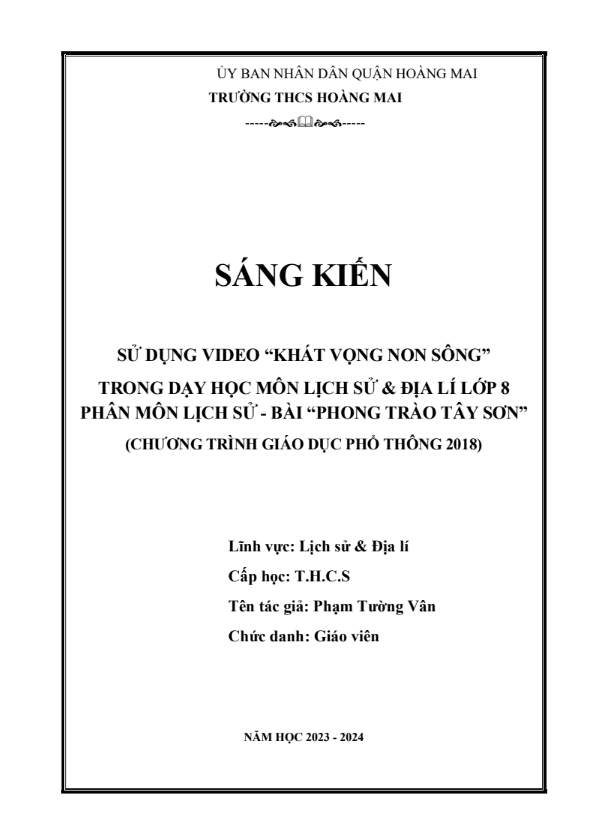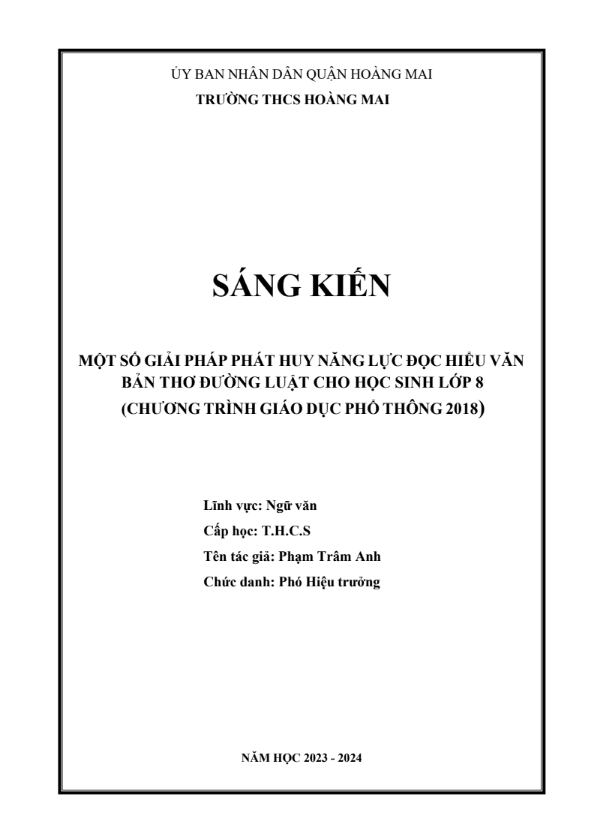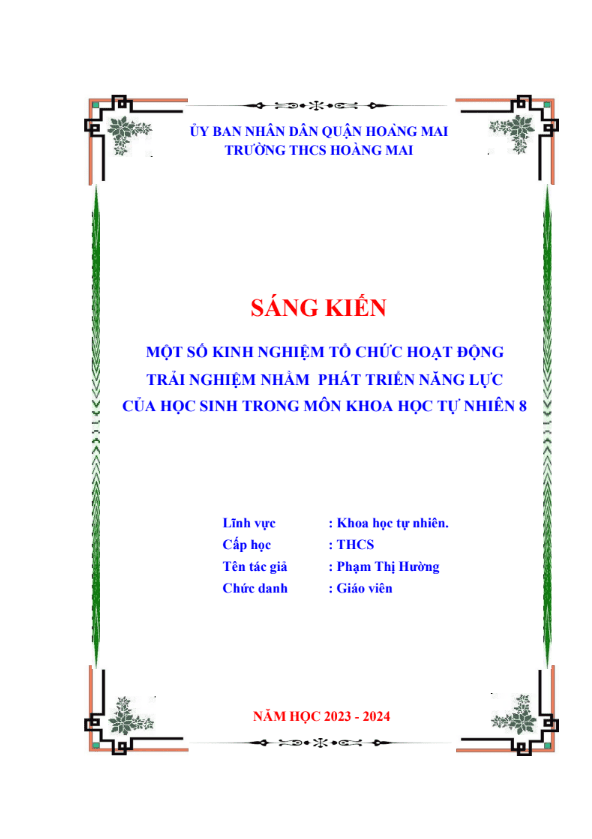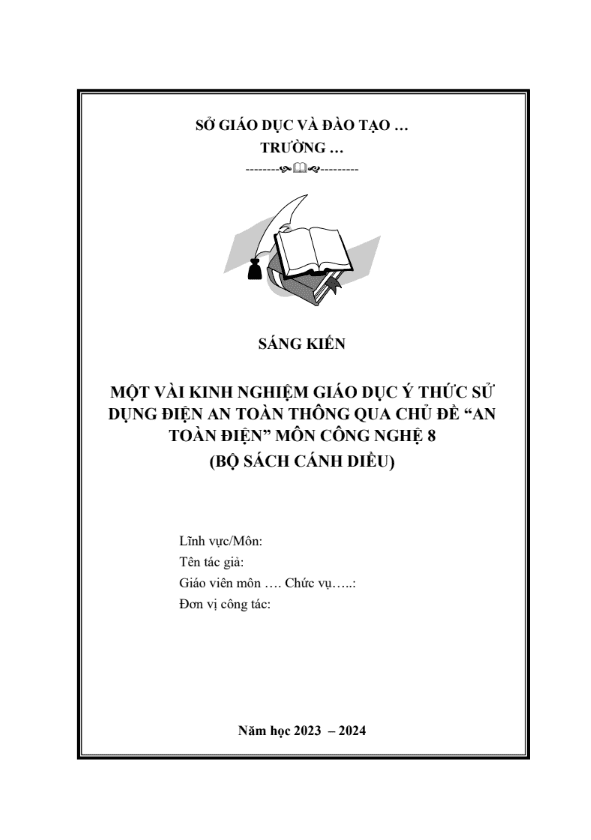SKKN Improving the way to pronounce english consonants of grade – 6 students
- Mã tài liệu: BM6122 Copy
| Môn: | Tiếng anh |
| Lớp: | 6 |
| Bộ sách: | |
| Lượt xem: | 946 |
| Lượt tải: | 7 |
| Số trang: | 19 |
| Tác giả: | Lê Thị Thanh |
| Trình độ chuyên môn: | Thạc sĩ giáo dục |
| Đơn vị công tác: | Trường THCS Alfred Nobel |
| Năm viết: | 2020-2021 |
| Số trang: | 19 |
| Tác giả: | Lê Thị Thanh |
| Trình độ chuyên môn: | Thạc sĩ giáo dục |
| Đơn vị công tác: | Trường THCS Alfred Nobel |
| Năm viết: | 2020-2021 |
Sáng kiến kinh nghiệm “SKKN Improving the way to pronounce english consonants of grade – 6 students” triển khai gồm các biện pháp nổi bật sau:
2.2.2. Suggested solution
Doing pronunciation exercises
a. Distinguishing sound exercises
b. Find the odd sounds
c. Matching exercises
Mô tả sản phẩm
INTRODUCTION
1.1. Justification of the research
We all know that during the time of studying English, there are many pronunciation errors that secondary students learning English tend to make such as word and sentence stress, intonation, length of vowel sounds, ending sounds and linking sounds, etc. To help better English pronunciation for students who learn English at secondary school, it’s is essential to do a search on most typical pronunciation problems of Vietnamese students, which is, in this research, errors with consonant sounds.
For secondary students, who have to learn English as their main subject, and then take exams in which English is one of the compulsory subjects. It’s extremely significant to realize their pronunciation errors. They cannot self-correct their English pronunciation so they are not confident enough to communicate in English. It’s obvious that there are some students noticing their pronunciation errors when their pronunciation erroneously, others, on the other hand, don’t recognize their problem with pronunciation English words.
Although there are common errors made by learners, not all the teachers pay attention to them. The conclusion partly from personal observation supports this research. It is possibly because some sounds are not pronounced so clearly as other sounds in an utterance so they are less noticed by both learners and teachers. In addition to this, there have not been many studies on these particular pronunciation errors so far at high level. Only studies about general speaking and pronunciation errors were carried out, which appears to have failed to emphasize the main pronunciation problem of Vietnamese students of English.
I believe that a study on English pronunciation errors will help students become well aware of their pronunciation problems to which they might not have paid any attention before. It’s also the help for some teachers in teaching pronunciation at schools if the study can recommend some solutions to help students practice pronunciation individually and in group. From the reasons mentioned above, I have decided to carry out this study entitled “Improving the way to pronounce English consonant sounds of grade-6 students”.
1.2. Aim and objectives of the research
English phonetics is important as it lays basis for effective oral communication. As far as I know, students of English at primary schools are not taught phonetics(and students at secondary schools who learn new curriculum are taught some sounds) and mostly taught by nonnative- English teachers.
Classes in Viet Nam are big so it is not suitable for teachers and students to practice pronunciation.
With the hope of getting more comprehensive and specific understanding of English consonants, finding out common consonants pronunciation mistakes faced by Vietnamese, my study focuses on:
Introducing the basic theories of English and their difficulties.
Particularly, giving the principles of consonants pronunciation and raising the learner awareness of English pronunciation by giving specific evidences, examples, figures, pictures may make learners try to pronounce like native speakers.
Providing some exercises may be very helpful for learners in English pronunciation as well as in English communication today.
- 3. Scope of the research
The study focuses on English errors made by students in grade 6, I do not have an ambition to cover all the students’ problems with English pronunciation. Only the pronunciation errors with some typical consonants made by the students in grade 6 are investigated.
- 4. Method of the research
Subjects of the research
This school year, I teach two classes in grade 6 with 66 students – 6A, 6B at Thi Tran Trieu Son secondary school but I choose 50 students participating in this study. They are about the same age; both genders and they come from many villages in Trieu Son district.
Data collection instruments of the research
Information in the study is collected in a natural way. In order to analyze the pronunciation errors that students in grade 6 make in their utterances, I have been observing in their lessons in class for many years and write down students’ errors. Then I analyze at home with the help of the attached CD and typescripts in the course book ” Pronunciation Made Simple” provided by an American teacher Ms. Mindy and many video clips about pronunciation on YouTube.
Data analysis procedure of the research
Firstly, I took students’ errors, checked whether they knew how to pronounce the words or not, I also counted how many students selected each pronunciation.
Secondly, I compared students’ errors with the guide books, sample videos.
Thirdly, I asked my colleagues about how to pronounce the words in the survey and the errors that students made.
- DEVELOPMENT
2.1. THEORETICAL BACKGROUND
This first part will provide readers with the related theoretical background of the study by introducing some key concepts necessary for the best perception of this research as well as the review of previous studies related to the topic. Central concepts chosen to be clarified in this part are English pronunciation, Standard pronunciation, English pronunciation Errors Aspects of pronunciation such as the articulator and English sounds.
Since the research have a strong desire to investigate the pronunciation errors in English, the definition of English pronunciation is especially important. Commonly speaking, pronunciation is simply put as “the way in which a language is spoken”[1]
There are 44 sounds in English. They are divided into two groups: 20 vowel sounds including 12 pure vowels, 8 diphthongs and 24 consonants. Some years ago, I had a study on vowel sounds so this time I just focus on consonants.
2.1.1. Definition of consonants in English
In articulator phonetic, a consonant is a speech of sound that is articulated with complete of partial closure of the upper vocal tract; the upper vocal tract is defined as that part of vocal tract lying above the larynx.[2]
Consonants are formed by interrupting, restricting or diverting the airflow in a variety of ways.[3]
2.1.2. The basic consonants in English include:
/b/, /p/, /k/, /g/, /t/, /d/, /v/ /f/, /s/, /z/, /h/, /0/, /d/, /m/, /n/, /l/, /r/, /w/, /y/, /g/, /Ɵ/, /ʒ/, /ʃ/, /ʧ/, /ʤ̄/
- Classification of English consonants
There are three ways of describing consonant sounds:
- The place of articulation
- The manner of articulation
- The voicing
- According to place of articulation
In English, there are six places in the mouth where the airstream is obstructed in the information of consonants.
In this study, we will discuss each consonant in terms of the articulators involved and the place in the mouth where the articulators cause an obstruction of the airstream.
*Sounds made with the lips
+ Both lips-bilabial: /p/, /b/, /m/
Pronounce the words “pat”, “bat” and “mat”, paying attention to the way the first consonants of each word is made. The first sound in each of these words is made with the two lips coming together and touching momentarily. The obstruction of the airstream thus occurs at the lips.
TÀI LIỆU LIÊN QUAN
- 0
- 114
- 1
- [product_views]
- 2
- 163
- 2
- [product_views]
- 3
- 183
- 3
- [product_views]
- 0
- 124
- 4
- [product_views]
- 0
- 134
- 5
- [product_views]
- 0
- 109
- 6
- [product_views]
- 5
- 101
- 7
- [product_views]
- 7
- 117
- 8
- [product_views]
- 1
- 174
- 9
- [product_views]
- 8
- 179
- 10
- [product_views]
















